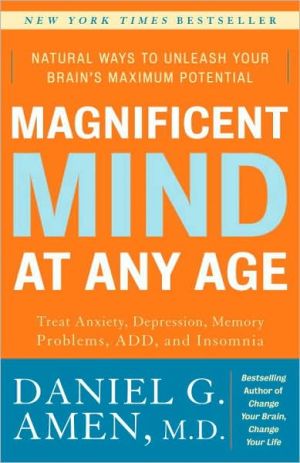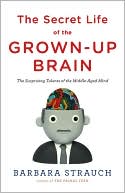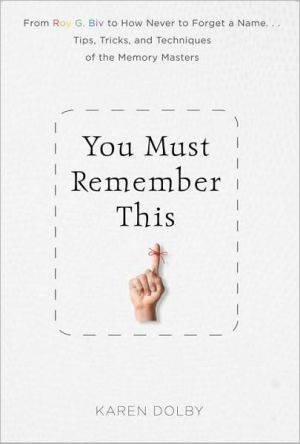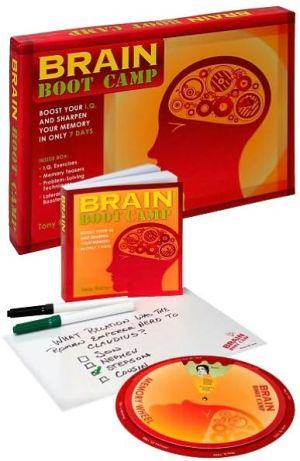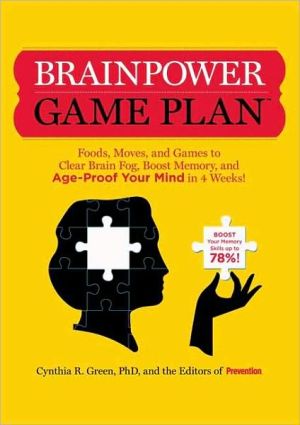Keep Your Brain Alive: 83 Neurobic Exercises to Help Prevent Memory Loss and Increase Mental Fitness
OVER 40? GETTING FORGETFUL? TROUBLE LEARNING NEW TRICKS?\ Introducing Neurobics, a unique brain exercise program based on the latest neuroscience research. These deceptively simple exercises help stimulate the production of nutrients that grow brain cells to keep the brain younger and stronger. Neurobics uses the five senses in unexpected ways and shakes up everyday routines. The exercises are offbeat, fun, and can be done anywhere, anytime. The result: a mind fit to meet any...
Search in google:
No more punch lines that just slipped away. No more names on the tip of your tongue. No more senior moments! Drawing on cutting-edge neurological research, how to keep your brain alive: 83 neurobic exercises brings help to everyone whose memory is starting to slip. Devised by Dr. Lawrence Katz, a professor of neurobiology at Duke University Medical Center, and Manning Rubin, author of 60 Ways to Relieve Stress in 60 Seconds, here is a regimen of mental cross-training that can be done anywhere, by anyone, at any time of day. The premise is simple: When you exercise the brain, you release natural growth factors called neurotrophins, which in turn enhance the brain's level of fitness. And nothing so easily stimulates the brain as breaking routines and using the five senses in new and unexpected ways. So if you're right-handed, wake up tomorrow and brush your teeth with your left hand. Or close your eyes before you get into the car and then get the key into the ignition. Every time you open a new circuit in your brain, it's like doing a round of mental sit-ups, without the pain.68,000 copies in print.
\ Preface\ As the population of over 76 million Baby Boomers approaches middle age and beyond, the issue of preserving mental powers throughout greatly increased life spans has reached an almost fever pitch. There is a growing interest in - and optimism about - preserving and enhancing the brain's capabilities into senior years. With the help of powerful new tools of molecular biology and brain imaging, neuroscientists around the world have literally been looking into the mind as it thinks. Almost daily, they are discovering that many of the negative myths about the aging brain are, indeed, only myths: "Older and wiser" is not just a hopeful cliche but can be the reality. In much the same way that you can maintain your physical well-being, you can take charge of your mental health and fitness.\ Although new and therefore not yet proved by large body of tests, Neurobics is based on solid scientific ground; it is an exciting synthesis of substantial findings about the brain that provides a concrete strategy for keeping the brain fit and flexible as you grow older.\ From Theory to Practice\ Jane reached into her pocketbook and fished inside for the keys to her apartment. Usually they were in the outside flap but not today. "Did I forget them?! No...here they are." She felt their shapes to figure out which one would open the top lock. It took her two tries until she heard the welcome click of the lock opening. Inside the door she reached to the left for the light switch...but why bother? Her husband would do that later. Touching the wall lightly with her fingertips, she moved to the closet on the right, found it, and hung up her coat. She turned slowly and visualized in her mind the location of the table holding her telephone and answering machine. Carefully she headed in that direction, guided by the feel of the leather armchair and the scent of a vase of birthday roses, anxious to avoid the sharp edge of the coffee table and hoping to have some messages from her family waiting.\ The table. The answering machine. She reached out and brushed her fingers across what she believed to be the play button. "What if I push the delete button?" she thought, and again checked to make sure she was right. Yesterday it was so easy. She could have done all this simply by looking around. Today was different. She could see nothing.\ But Jane had not suddenly gone blind. At age 50, she was introducing a lifestyle strategy called Neurobics into her daily activities. Based on recent discoveries in brain science, Neurobics is a new form of brain exercise designed to help keep the brain agile and healthy. By breaking her usual homecoming routine, Jane had placed her brain's attentional circuits in high gear. With her eyes closed, she had to rely on her senses of touch, smell, hearing, and spatial memory to do something they rarely did - navigate through her apartment. And she was involving her emotional sense by feeling the stresses of not being able to see. All these actions created new and different patterns of neuron activity in her brain - which is how Neurobics works.\ This book will explain the principles behind Neurobics and how the exercises enhance the overall health of your brain as you grow older.\ BRUSHING ROULETTE\ Brush your teeth with your nondominant hand (including opening the tube and applying toothpaste). You can substitute any morning activity - styling your hair, shaving, applying makeup, buttoning clothes, putting in cuff links, eating or using the TV remote.\ • This exercise requires you to use the opposite side of your brain instead of the side you normally use. Consequentially, all those circuits, connections, and brain areas involved in using your dominant hand are inactive, while their counterparts on the other side of your brain are suddenly required to direct a set of behavior in which they usually don't participate. Research has shown that this type of exercise can result in a rapid and substantial expansion of circuits in the parts of the cortex that control and process tactile information from the hand.\ Variation\ Use only one hand to do tasks like buttoning a shirt, tying a shoe, or getting dressed. For a real workout, try using just your nondominant hand.\ Another exercise that associates unusual sensory and motor pathways in your cortex with a routine activity is to use your feet to put your socks and underwear in the laundry basket or pick out your shoes for the day.\ Excerpted from How to Keep Your Brain Alive. Copyright (c) 1999 by Lawrence C. Katz and Manning Rubin. Reprinted with permission by Workman Publishing.
Preface Neurobics: The New Science of Brain Exercise How the Brain Works How Neurobics Works Starting and Ending the Day Commuting At Work At the Market At Mealtimes At Leisure

